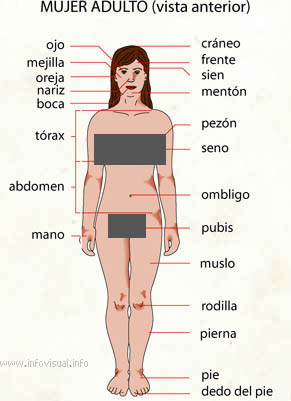Adulto

Cráneo : Caja osea que contiene el encefalo.
Frente: Parte de la cara entre la raiz de los pelos y las cejas.
Sien : Parte de la cabeza entre el ojo y la parte superior de la oreja.
Mentón: Prominencia de la mandibula inferior.
Pezón : Protuberancia que forma el extremo del seno.
Seno : Parte anterior del pecho donde son los pezones.
Ombligo: Cicatriz que queda después de desprenderse del cordon umbilical.
Pubis: Parte inferior del vientre inferior que se cubre de los pelos a la pubertad.
Muslo: Parte superior del miembro inferior que contiene el fémur.
Rodilla : Articulacion entre el muslo y la pierna.
Pierna : Parte inferior del miembro inferior.
Pie: Parte del miembro inferior que sostiene su cuerpo.
Dedo del pie : Extremidad del pie.
Mano: Parte del cuerpo humano que termina el brazo, compuesto de cinco (5) dedos, y permiten el tacto y a la prension.
Abdomen: Parte inferior del tronco que contiene los organos digestivos.
Tórax: Parte superior del tronco delimitado por el diafragma y las costillas.
Boca: Orificio del conducto digestivo, situada en la parte inferior de la cara.
Nariz: Parte protuberante de la cara entre la boca y el frente, donde esta la respiracion.
Oreja: Organo externo del pabellon auricular.
Mejilla : Parte de la cara entre la nariz y oreja, el ojo y el maxilar inferior.
Ojo: Organo de la vista.
Foto :

Domestic goats are one of the oldest domesticated species. For thousands of years, goats have been used for their milk, meat, hair, and skins all over the world. Most goats naturally have two horns, of various shapes and sizes depending on the breed. While horns are a predominantly male feature, some breeds of goats have horned females. Polled (hornless goats) are not uncommon and there have been incidents of polycerate goats (having as many as eight horns), although this is a genetic rarity thought to be inherited. Their horns are made of living bone surrounded by keratin and other proteins and are used for defense, dominance, and territoriality.
Goats are ruminants. They have a four-chambered stomach consisting of the rumen, the reticulum, the omasum, and the abomasum. Goats have horizontal slit-shaped pupils, an adaptation which increases peripheral depth perception. Because goats' irises are usually pale, the pupils are much more visible than in animals with horizontal pupils but very dark irises, such as sheep, cattle and most horses.
Both male and female goats have beards, and many types of goats may have wattles, one dangling from each side of the neck. Some breeds of sheep and goats appear superficially similar, but goat tails are short and point up, whereas sheep tails hang down and are usually longer, though some are short, and some long ones are docked.